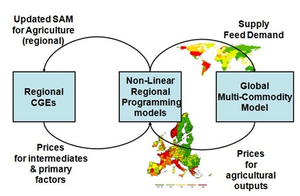CAPRI in brief
CAPRI is an economic model developed by European Commission research funds. It supports decision making related to the Common Agricultural Policy based on scientific quantitative analysis. The objective is to evaluate exante impacts of the Common Agricultural Policy and trade policies on production, income, markets, trade, and the environment, from global to regional scale.
Type
Please follow the link: CAPRI projects and funding
Network and co-operation
Please follow the link: CAPRI network
What is unique?
CAPRI has a transparent link between regional or even farm type aggregate programming models covering EU's agriculture in a rather differentiated way with a complex global model for trade in agricultural products.
Data
CAPRI is sourced mainly by EUROSTAT, FAOSTAT, World Bank, the European Farm Accountancy Data Network (FADN) and other statistics. The major effort is to build a complete, closed and consistent agricultural data base across scales.
Regional coverage
CAPRI iteratively links a Supply module (mathematical programming models) covering the EU27 + Norway + Western Balkans (250 regions on NUTS II and/or even up to six farm types for each region) and a spatial, global multi-commodity Market module for agricultural products for 47 product in 60 countries in 28 trade blocks. Sectors and products.
Sectors and products
The supply module comprises about 50 crop and animal activities for each of the around 250 regions (at the so-called NUTS-2 level), and includes about 50 inputs and outputs. Each independent model maximises regional agricultural income at given prices and subsidies, subject to constraints on land, policy variables and feed und plant nutrient requirements in each region. Most crop activities features a higher and lower intensive variant to allow for endogenous yield adjustments.
Agricultural policy instruments
Production quotas for milk; A and B selling quotas for sugar beet in conjunction with A,B,C, prices; set-aside; the different premiums of the Common Agricultural Policy.
Market module
It covers about 40,000 equations and variable which are solved simultaneously. Some of the equations are also highly non-linear. Nevertheless, with good starting values, it can be solved in a few seconds. The parameters for the CAPRI market model had not been estimated by the CAPRI team, but are borrowed from other models or publications. The supply, processing, feed and final demand function in the CAPRI market model are flexible in the sense they comprise enough parameter to be calibrated to any regular set of own and cross price elasticities. Regular means that the parameter set is calibrated as to be in line with the assumption of profit maximizing producers and utility maximizing consumers.
Endogenous variables
Yield: The crop production activities in each region are presented by a low and high yield variant which substitutes against each other. On top, yield results shown for higher regional aggregates (Member States, Regions) are a weighted average over the NUTS II regions, so that yields above regional level may change even if no yield changes are simulated per NUTS II region. Prices: In the overall modeling system, the global trade model is responsible for simulating market clearing prices, so that prices are endogenous. However, during solution of the regional supply models, prices are fix and given, and the farmers react as price takers. An iterative link between the supply and market models ensures convergence between the prices used in the supply models and the ones generated by the market models.
Software
Technically, CAPRI is realised in GAMS and steered by a Graphical User Interface realised in Java. The GAMS code and the data base are hosted on SVN version control server.







